Timgad of Algeria
Timgad, an ancient Roman city in Algeria, is a fascinating testament to the Roman Empire’s architectural and cultural achievements. The city is renowned for its impressive grid layout, typical of Roman urban planning, which includes a forum, basilica, and an extensive network of streets lined with colonnades. Among its remarkable structures is the grand theater, which could seat thousands and stood as a venue for cultural events and performances. The marble-lined square, known as the forum, was the heart of civic life, showcasing the vibrant social and political dynamics of the time.
Surrounded by the stunning Aurès Mountains, Timgad not only offers a glimpse into the architectural grandeur of the Roman era but also provides breathtaking views that make it a unique site for both history enthusiasts and photographers alike. The remnants of temples, baths, and houses reveal stories of daily life in ancient Rome, allowing visitors to immerse themselves in the rich history of this UNESCO World Heritage Site. Overall, Timgad is a captivating destination for anyone eager to explore the remnants of Roman civilization and its lasting legacy in the landscape of Algeria.
Table of Contents
Where is the location of Timgad?
Timgad is an ancient Roman city in Algeria. It is located north of the Aurès massif in a beautiful mountainous region, about 480 kilometers southeast of Algiers and 110 kilometers south of the city of Constantine. Timgad is an excellent example of how the Romans built a military settlement from the ground up.
Inscription of Timgad
Timgad was recognized as a UNESCO World Heritage Site in 1982, highlighting its significance as an ancient Roman city. This site is essential because it shows how the Romans lived and built towns in North Africa. The impressive structures they created are a testament to their architectural skills and have stood the test of time, lasting for many centuries.
What is the history of Timgad?
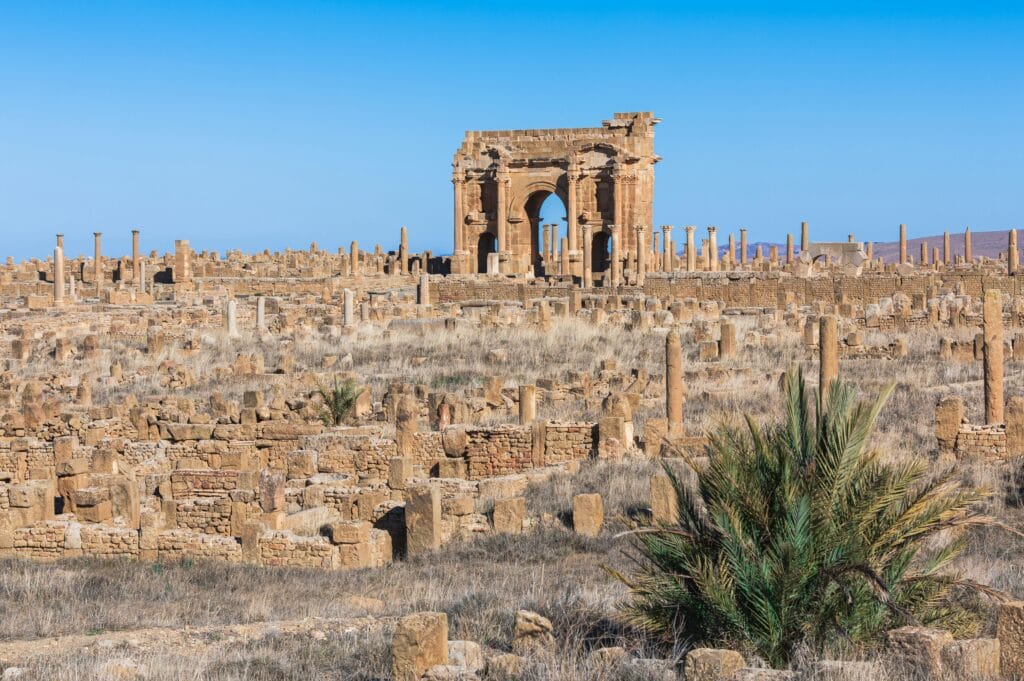
Timgad is a remarkable example of a Roman town that was built from the ground up. It was established in 100 AD by Emperor Trajan and was initially called Colonia Marciana Traiana Thamugadi. By the middle of the 2nd century, Timgad experienced rapid growth, expanding beyond its initial boundaries. During the time when Christianity was spreading, Timgad became an important center for the church and was known for having a bishop.
After the Vandal invasion in 430, the city of Timgad was destroyed by groups known as Montagnards from the Aurès region at the end of the 5th century. Later on, during the Byzantine Reconquest, some activities in the city picked up again. A fortress was built to the south in 539 to protect the town, using materials taken from old Roman buildings. However, the arrival of the Arabs led to the city’s final decline, and by the 8th century, Timgad was abandoned entirely.
Today, the ancient city of Timgad showcases its impressive and well-preserved ruins, which feature the classic layout of Roman streets. Visitors can see the remnants of a library, a large gathering place called a basilica, and several temples, all highlighting the city’s fascinating past. Recognized as a UNESCO World Heritage site, Timgad is celebrated for its cultural and historical importance, making it a popular destination for tourists and history lovers alike.
What is the architecture of Timgad?
Timgad is one of the best-preserved examples of ancient Roman city planning and architecture. It features a unique grid layout and several important buildings. Founded around 100 AD by the Roman Emperor Trajan as a military settlement, Timgad showcases how Romans designed their towns with organized streets and well-thought-out structures. It is a remarkable example of how Roman cities were built and planned.
Most of the buildings in Timgad were constructed during the reign of the Severan emperors. This ancient city was a vibrant colony that displayed Rome’s power and influence in the Numidia region. Many of its stone structures were repaired and restored during the Roman Empire. Notable restorations include the Trajan Arch in the middle of the 2nd century, as well as the Eastern Gate in 146 and the Western Gate during the reign of Marcus Aurelius.
Timgad is a fascinating ancient city that features many well-preserved Roman structures, including the impressive Arch of Trajan, the Capitolium, a Timgad Theater, Public Baths, and a Library of Timgad. Because of its importance in archaeology, Timgad is often compared to Pompeii, another famous historical site. The remains of this city give us a glance into the daily life, social structure, and architectural achievements of the Romans, making it a treasure for both history enthusiasts and tourists alike.
What is the Arch of Trajan? What is the Arch of Trajan famous for?
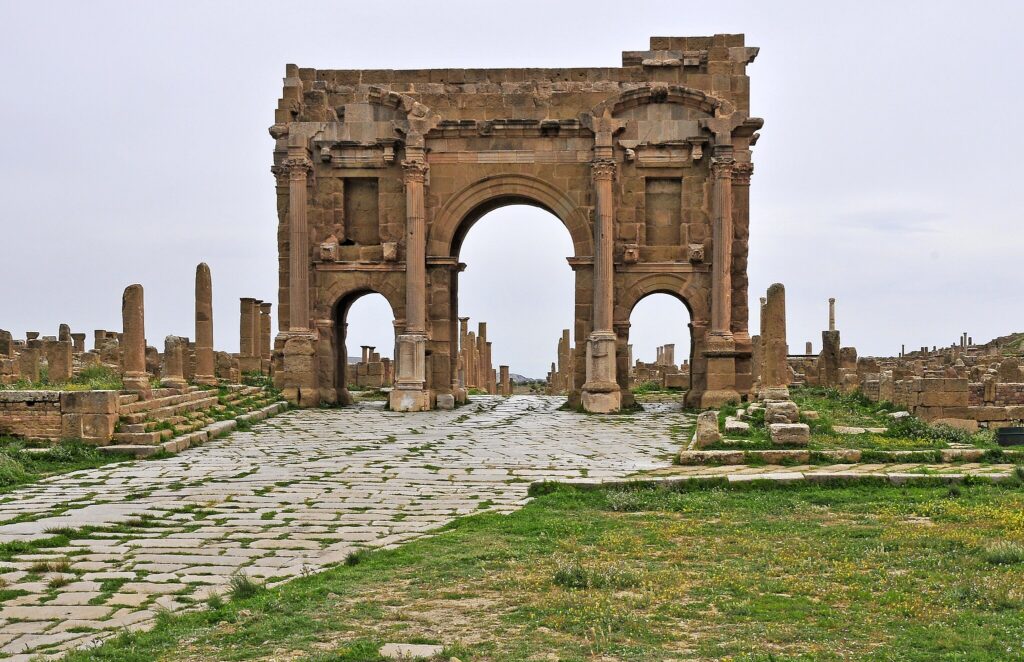
The Arch of Trajan is a well-known landmark located in Timgad, a city in North Africa. It stands at the western end of Timgad’s main road, known as the Decumanus Maximus. Built in around 100 AD to honor Emperor Trajan, this monument showcases the strength and reach of the Roman Empire in the region. The arch represents a classic style of Roman architecture used to celebrate victories and important events. As a grand entrance, the arch welcomed visitors into the lively streets filled with shops, public buildings, and marketplaces. It was an important part of the city’s layout and design, guiding people into the heart of Timgad.
The Arch of Trajan has stood the test of time, remaining in great condition even after being exposed to the weather for many years. This impressive structure lets visitors appreciate the exceptional talent of Roman architecture and their beautiful designs. Today, the Arch of Trajan is a popular spot to visit in Timgad. It offers a glimpse into the history of the ancient Roman Empire in Africa. Many people come to take photos and to think about the fantastic achievements in architecture and culture from that era.
What is the Capitolium? What is the Capitolium famous for?
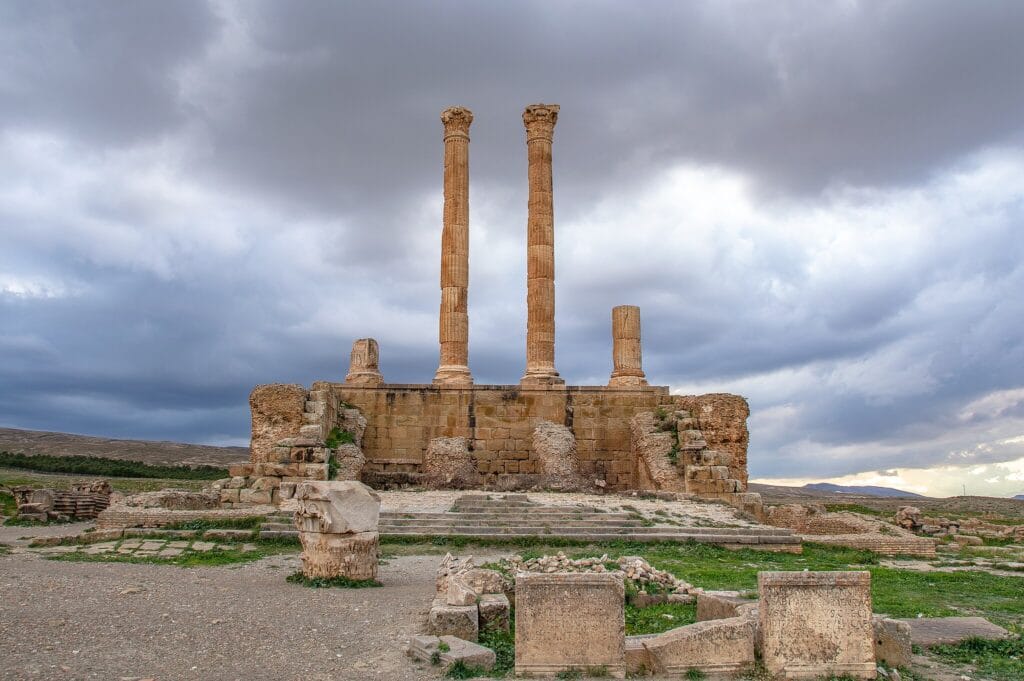
The Capitolium is a magnificent temple located close to the main square in Timgad. It’s dedicated to three major Roman gods: Jupiter, Juno, and Minerva. This temple is an excellent example of the impressive architecture and religious significance that Roman towns are known for, and it’s one of the most striking buildings you can find at the Timgad archaeological site.
The Capitolium stands on a raised platform designed in the style of ancient Roman temples. It features a prominent staircase leading up to the main entrance. Even though the Capitolium is mostly in ruins today, you can still see enough of its structure to appreciate its grand size and beautiful details. Some columns and parts of the foundation are still intact, allowing visitors to envision how magnificent it once was and the admiration it commanded in the past.
The Capitolium in Timgad highlights the importance of religion in the daily lives of the Romans. It showcases the impressive architectural skills that allowed their temples to withstand the test of time. For visitors, it serves as an essential symbol of Roman culture and is a must-see attraction when exploring the archaeological treasures of Timgad.
What is the Timgad Theatre famous for?
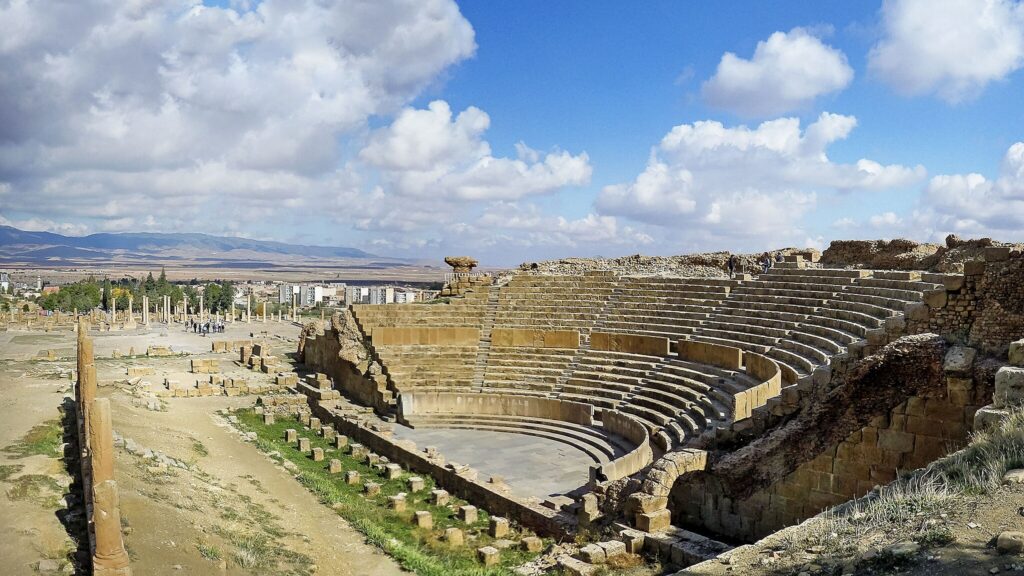
The Timgad Theater is a remarkable building located on a hillside in the ancient town of Timgad. This theater was used for various activities such as plays, community gatherings, and political discussions. It’s one of the best-preserved structures from this ancient Roman city, giving us a glimpse into how people enjoyed entertainment and connected in those times. Roman theaters were important places where communities came together to enjoy cultural events, helping to strengthen their sense of belonging and shared identity among the diverse people living in Timgad.
Today, many tourists come to see the Timgad Theater, which showcases the impressive skills of Roman builders who cleverly designed it to fit the surrounding landscape. This theater highlights the essential cultural aspects of the Roman Empire, focusing on public entertainment and gathering spaces for the community. For visitors today, it offers a fascinating look into the vibrant life of ancient Timgad and is an essential part of what makes it a UNESCO World Heritage Site.
What is the Library of Timgad?
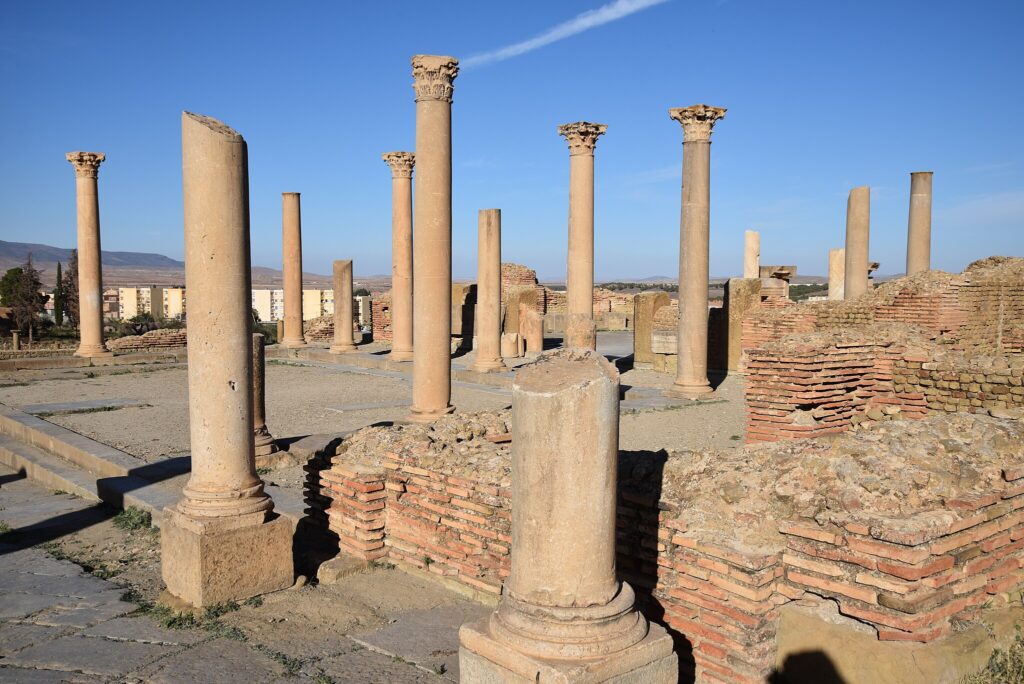
The Library of Timgad is a fascinating place that showcases the ancient Romans’ love for learning and literature. It is a remarkable part of North African history, revealing an important side of Roman culture. Built around the 3rd century AD, this library is one of the few known from the Roman era, reflecting how much the Romans valued education. Although the library is now in ruins, you can still see some of its walls, alcoves, and decorative elements, which help archaeologists and visitors imagine what the library looked like in its prime. That makes the Library of Timgad a unique and meaningful part of the area’s archaeological heritage.
What is Timgad famous for?
Timgad is known for its well-preserved ruins from the Roman era, showcasing impressive urban design and architecture from ancient times. Established in the 1st century AD, this historical site has a layout that resembles a grid, featuring an impressive central square, temples, and the well-known Arch of Trajan. Timgad is a key example of a Roman town in North Africa and provides important insights into the history and culture of that time.
Why do we need to preserve Timgad significantly for us and future generations?
Preserving Timgad is essential for several reasons. Firstly, it is a vital link to ancient history, showcasing Roman urban planning and architecture. This archaeological site offers insights into the social, economic, and cultural dynamics of past civilizations. By safeguarding Timgad, we ensure that future generations can learn from and appreciate this rich heritage. Additionally, it can promote education, tourism, and cultural exchange, contributing to local communities’ economic development while fostering a sense of identity and continuity. Preserving such sites helps maintain our collective memory and enriches our understanding of human history.
Why should you visit the Timgad as a visitor?
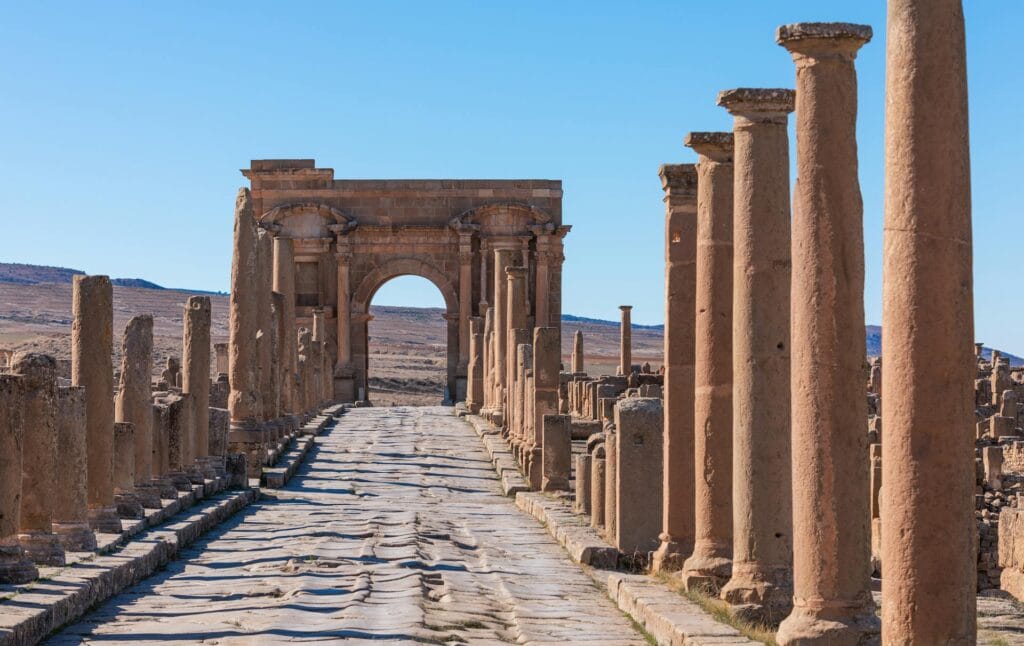
Visiting Timgad offers an extraordinary glimpse into the ancient Roman world and its remarkable buildings. This site is recognized by UNESCO World Heritage site, famous for its well-preserved ruins, including a grand theater, an elegant square lined with marble, and beautiful mosaics. Walking through Timgad’s historic streets allows you to imagine what life was like in a bustling Roman city. The stunning backdrop of the Aurès Mountains adds to the beauty of Timgad, making it an ideal spot for photos and reflection. Whether you love history, are intrigued by impressive structures, or simply want to explore somewhere unique, Timgad promises an unforgettable experience.
How will visiting Timgad enhance your understanding of ancient Roman culture?
Don’t miss the chance to step back in time and immerse yourself in the wonders of Timgad! Plan your visit today and experience the breathtaking ruins, rich history, and stunning landscapes firsthand. Whether you’re an avid history buff or just looking for a unique travel adventure, Timgad awaits—book your trip and uncover the secrets of this remarkable UNESCO World Heritage site!
When you’re planning your adventure, enhance your travel experience by using trusted websites like GetYourGuide and Trip.com! These platforms offer a variety of enjoyable tours, activities, and accommodation options to suit every traveler’s needs.
- GetYourGuide offers a wide variety of unforgettable travel experiences. You can choose from tickets to Popular Attractions, Transportation Options, City Passes, Guided Tours, Hop-on Hop-off Bus Services, Water Activities, Day trips, and Trips that last several days in many locations around the world.
- Trip.com makes it easy to combine Flights and Hotels, Trains, Car Rentals, Airport Transfers and Attractions & Tours to create the perfect travel package tailored just for you.
Start your journey with our reliable travel partners and unlock the best of Timgad and beyond!
Disclaimer
In this post, affiliate links are included and those links are associated with well-known travel companies such as GetYourGuide and Trip.com. If you choose to purchase or book a service using those links, we may earn a commission at no additional cost to you. We focus on recommending products and services that are helpful to you and we appreciate your support!
Conclusion
We hope you find this information helpful for your next trip. If you want to learn more, check out our other travel blog posts. We cover many topics, including amazing places to visit and helpful travel tips. Whether you’re looking for hidden gems, new cultures, or helpful advice, there’s something for everyone.
Additionally, If you enjoyed the information we shared, don’t forget to explore our other travel product reviews to make your journey even better! Please take a moment to look through our previous posts and let your sense of adventure guide you on your next journey! We wish you happy travels and look forward to sharing more with you in our next blog post!




